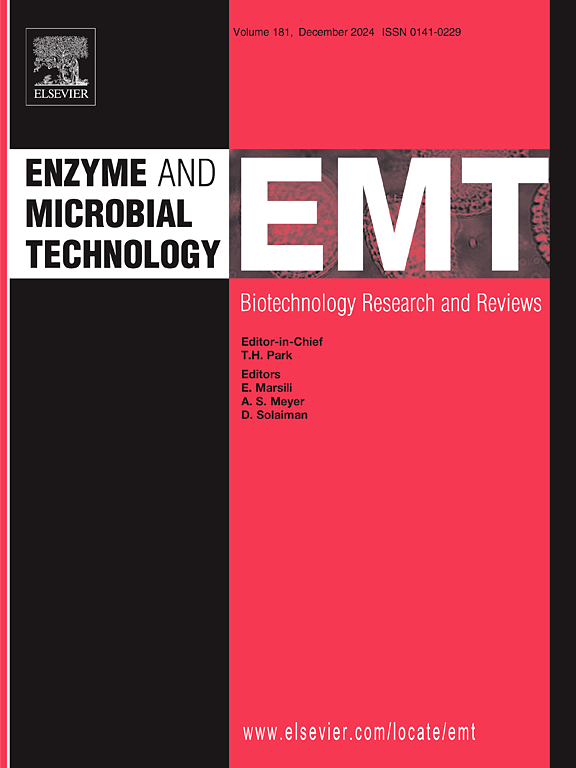Engineering of ω-transaminase at binding pocket and access tunnel for preparation of (R)-1-phenoxypropan-2-amine
IF 3.7
3区 生物学
Q2 BIOTECHNOLOGY & APPLIED MICROBIOLOGY
引用次数: 0
Abstract
Transaminase-catalyzed amination of prochiral ketones is regarded as a promising route for optically active amines production. These chiral amines serve as key building blocks in the synthesis of agrochemicals and pharmaceuticals. However, the limited substrate scope and substrate/(co)product inhibition have significantly hindered the industrial-scale implementation of transaminase-catalyzed processes. Engineering of TAs at binding sites is an efficient strategy to expand the capacity of binding pocket, thereby improving the catalytic efficiency. Furthermore, modification of access tunnel is crucial for adjusting the transfer efficiency of ligand. In this endeavor, we engineered an ω-TA from Nocardioides sp. CER19(NsTA) at binding sites and access tunnel, and applied the mutants for enantioselective synthesis of (R)-1-phenoxypropan-2-amine. Mutation at residues H62 and Y122 increased catalytic activity of the TA towards 1-phenoxyacetone, the optimal mutants NsTAH62A and NsTAY122A with improved enzyme activity was obtained, which was 2.0 and 1.5-fold higher than that of the wild-type NsTA respectively. This allowed completely conversion of 5 mM 1-phenoxyacetone to (R)-1-phenoxypropan-2-amine at 4 h and > 99 % ee (in comparison to 66 % convesion with the wild-type NsTA). Molecular dynamic simulation suggested improved flexibility of NsTAH62A, which may result in eliminating of substrate inhibition. While mutant NsTAD7 (with deletion of 7 amino acids at N-terminal) exhibited about 1.6-fold increase of conversion. Tunnel analysis suggested that reshaping of the tunnel entrance may alter the shape and size of the tunnel, which might promote the release of the products. These results of our study lay the foundation for enantioselective synthesis of (R)-1-phenoxypropan-2-amine and provide a promising engineering strategy to enhance the activity of TAs and overcome substrate/(co)product inhibition of ω-TA towards bulky substrates.
制备(R)-1-苯氧丙烷-2-胺的结合袋和通道ω-转氨酶工程
转氨酶催化的前手性酮胺化反应被认为是一种很有前途的光活性胺生产途径。这些手性胺是合成农用化学品和药品的关键组成部分。然而,有限的底物范围和底物/(co)产物抑制严重阻碍了转氨酶催化过程的工业规模实施。在结合位点进行TAs工程是扩大结合袋容量从而提高催化效率的有效策略。此外,通道的修饰是调节配体转移效率的关键。在这项工作中,我们从Nocardioides sp. CER19(NsTA)中设计了一个ω-TA在结合位点和通道上,并应用该突变体进行(R)-1-phenoxypropan-2-amine的对体选择性合成。突变位点H62和Y122增加了TA对1-苯氧丙酮的催化活性,获得了酶活性提高的最佳突变体NsTAH62A和NsTAY122A,分别比野生型NsTA高2.0倍和1.5倍。这使得5 mM 1-苯氧丙酮在4 h和>; 99 % ee下完全转化为(R)-1-苯氧丙烷-2-胺(与野生型NsTA的66 %转化率相比)。分子动力学模拟表明,NsTAH62A的柔韧性得到了提高,这可能导致底物抑制的消除。突变体NsTAD7(在n端缺失7个氨基酸)的转化率提高了约1.6倍。隧道分析表明,隧道入口的改造可能会改变隧道的形状和大小,从而促进产品的释放。这些研究结果为(R)-1-苯氧丙烷-2-胺的对映选择性合成奠定了基础,并为提高TAs活性和克服ω-TA对大体积底物/(co)产物的抑制作用提供了有前途的工程策略。
本文章由计算机程序翻译,如有差异,请以英文原文为准。
求助全文
约1分钟内获得全文
求助全文
来源期刊

Enzyme and Microbial Technology
生物-生物工程与应用微生物
CiteScore
7.60
自引率
5.90%
发文量
142
审稿时长
38 days
期刊介绍:
Enzyme and Microbial Technology is an international, peer-reviewed journal publishing original research and reviews, of biotechnological significance and novelty, on basic and applied aspects of the science and technology of processes involving the use of enzymes, micro-organisms, animal cells and plant cells.
We especially encourage submissions on:
Biocatalysis and the use of Directed Evolution in Synthetic Biology and Biotechnology
Biotechnological Production of New Bioactive Molecules, Biomaterials, Biopharmaceuticals, and Biofuels
New Imaging Techniques and Biosensors, especially as applicable to Healthcare and Systems Biology
New Biotechnological Approaches in Genomics, Proteomics and Metabolomics
Metabolic Engineering, Biomolecular Engineering and Nanobiotechnology
Manuscripts which report isolation, purification, immobilization or utilization of organisms or enzymes which are already well-described in the literature are not suitable for publication in EMT, unless their primary purpose is to report significant new findings or approaches which are of broad biotechnological importance. Similarly, manuscripts which report optimization studies on well-established processes are inappropriate. EMT does not accept papers dealing with mathematical modeling unless they report significant, new experimental data.
 求助内容:
求助内容: 应助结果提醒方式:
应助结果提醒方式:


